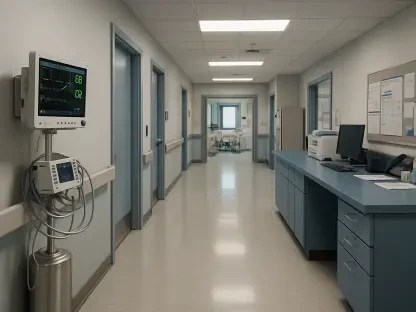Endometriosis, a chronic and often debilitating condition affecting at least one in ten women of reproductive age globally, continues to pose significant diagnostic challenges for medical professionals and patients alike, leaving many desperate for answers. Characterized by tissue similar to the uterine lining growing outside the womb, it frequently results in severe pain and heightened infertility risks. The current gold standard for diagnosis involves invasive surgery under general anesthesia, a process that can delay confirmation for years. Amid this struggle, a saliva-based test called Endotest, developed by French start-up Ziwig, has emerged as a potential game-changer, promising a non-invasive alternative. Using cutting-edge artificial intelligence and microRNA technology, the test aims to detect all forms of the condition with a simple sample. However, while hope surrounds this innovation, growing skepticism from the scientific community about its reliability and the evidence behind it casts a shadow over its widespread adoption.
The Promise of Non-Invasive Diagnosis
A Breakthrough on the Horizon
The introduction of the Endotest has sparked considerable interest among those affected by endometriosis, offering a glimpse of hope for a less invasive diagnostic pathway. Unlike the current surgical approach, which requires patients to undergo general anesthesia and face significant recovery time, this saliva-based test could transform how the condition is identified. By leveraging artificial intelligence alongside microRNA analysis, the technology claims to detect even complex cases of endometriosis through a straightforward sample. Such a development could drastically reduce the years of uncertainty many women endure before receiving a diagnosis, potentially enabling earlier interventions and better management of symptoms. The appeal of avoiding surgery resonates deeply with patients who often face physical and emotional tolls from the existing process, positioning the Endotest as a beacon of progress in women’s health.
Beyond the immediate benefit to patients, the broader implications of a successful non-invasive test are profound for the medical field. If validated, this technology could set a precedent for diagnosing other conditions through similar biomarker-based methods, pushing the boundaries of personalized medicine. The reduction in surgical procedures would also alleviate pressure on healthcare systems, cutting costs and wait times for specialized care. For researchers, the Endotest represents an opportunity to deepen understanding of endometriosis at a molecular level, potentially unlocking new insights into its mechanisms. However, the excitement surrounding this innovation is tempered by questions about whether the test can deliver on its ambitious promises. The gap between theoretical potential and proven efficacy remains a critical hurdle, with many in the scientific community urging caution until more robust data emerges to support its claims.
Addressing a Long-Standing Gap
For decades, the lack of accessible diagnostic tools has compounded the challenges faced by those with endometriosis, often leading to misdiagnosis or dismissal of symptoms as mere discomfort. The Endotest aims to bridge this gap by providing a method that could be easily integrated into routine medical checkups, eliminating the need for invasive confirmation. This could be particularly transformative for younger women or those in regions with limited access to specialized gynecological care, where surgical diagnosis is often out of reach. The simplicity of a saliva sample means testing could occur in a primary care setting, democratizing access to early detection. Advocates argue that such a shift would not only improve individual outcomes but also raise awareness of the condition on a societal level, encouraging more open conversations about women’s health issues.
Moreover, the psychological impact of a non-invasive diagnostic tool cannot be understated, as the current process often adds stress and anxiety to an already burdensome condition. Women frequently report feeling unheard or invalidated when seeking answers, and a simpler test could validate their experiences sooner, fostering trust in healthcare providers. Yet, while the vision of widespread, accessible testing is compelling, the reality hinges on the Endotest’s ability to perform consistently across diverse populations. Concerns linger about whether the technology accounts for variations in genetic or environmental factors that might affect results. Until these uncertainties are addressed through comprehensive studies, the dream of a universally applicable diagnostic solution remains just out of reach, fueling ongoing debates within medical circles.
Government Support and Public Funding
Unprecedented Backing
The French government’s commitment to the Endotest stands out as an extraordinary example of state involvement in medical innovation, reflecting a deep investment in addressing women’s health challenges. Since incorporating the test into the national strategy to combat endometriosis, launched several years ago, officials have provided both political and financial support at an unprecedented level. High-ranking figures, including Health Minister Catherine Vautrin, have publicly endorsed the test, with statements of support even appearing on promotional platforms associated with Ziwig, the test’s developer. This rare alignment between government and a private biotech entity underscores a deliberate effort to position France as a leader in medical technology, with the Endotest serving as a flagship initiative in the fight against a pervasive condition.
Financially, the backing translates into a substantial burden on taxpayers, with an estimated 21 million euros (approximately $25 million USD) allocated to reimburse patients for accessing the Endotest. This level of funding for a single diagnostic tool is striking, especially in a healthcare landscape where resources are often spread thin across multiple priorities. Proponents of the government’s stance argue that such investment is justified by the potential to revolutionize diagnosis and improve quality of life for countless women. However, the depth of this commitment has raised eyebrows among observers who question whether such singular focus is appropriate without definitive proof of the test’s efficacy. The intertwining of political will and commercial interests adds another layer of complexity, prompting calls for greater transparency in how decisions are made at this intersection.
Funding Disparities
Criticism over resource allocation has emerged as a significant point of contention surrounding the French government’s approach to the Endotest, with many highlighting a stark imbalance in funding priorities. While 21 million euros are directed toward reimbursing patients for the test, only 11 million euros (around $13 million USD) are earmarked for broader endometriosis research under the national women’s health program. This disparity has fueled concerns among researchers and advocates who argue that such a narrow focus risks stifling other promising avenues of innovation. Alternative diagnostic methods, such as advancements in ultrasound interpretation, could offer complementary or even superior solutions if given adequate support, yet they remain underfunded in comparison to the heavily promoted saliva-based test.
The implications of this funding gap extend beyond immediate diagnostic tools, touching on the future of comprehensive care for endometriosis patients. Experts like Ludivine Doridot from the French research organization Inserm caution that diverting resources so heavily toward one product may slow overall progress in understanding and treating the condition. A more balanced approach, they suggest, would invest in a range of studies and technologies to ensure no potential breakthrough is overlooked. Critics also point out that the emphasis on a commercial product raises questions about whether public funds are being used to prioritize national prestige over patient outcomes. As debates continue, the challenge lies in finding an equilibrium that fosters innovation while addressing the diverse needs of those affected by this complex disorder.
Scientific Skepticism and Validation Challenges
Doubts from Experts
Despite the optimism surrounding the Endotest, the scientific community has voiced substantial doubts about the robustness of the evidence supporting its effectiveness, casting uncertainty over its readiness for widespread use. Studies cited by Ziwig, published in reputable journals such as the Journal of Clinical Medicine and NEJM Evidence, have come under scrutiny for their limited scope and methodological shortcomings. British statistics professor Kevin McConway, among others, has pointed out that these studies, often based on small cohorts of fewer than 200 participants, lack the external validation necessary to confirm reliability across broader populations. Such preliminary findings, while intriguing, fall short of the rigorous standards typically required for diagnostic tools to gain universal acceptance in medical practice.
Further compounding these concerns is the question of representativeness in the research populations studied, which often consisted of individuals already suspected of having endometriosis. This narrow focus raises doubts about whether the test can accurately detect the condition in less obvious cases or among diverse demographic groups with varying genetic profiles. Without larger, more inclusive trials, the scientific consensus leans toward caution, with many experts advocating for additional data before the test is rolled out on a larger scale. The gap between initial results and proven efficacy underscores a broader tension in medical innovation: the rush to bring solutions to market versus the need for meticulous validation to protect patient trust and safety.
Regulatory Caution
Adding to the scientific skepticism, the French Health Authority (HAS) has adopted a notably restrained stance on the Endotest, reflecting a disconnect between governmental enthusiasm and regulatory oversight. While acknowledging the test’s potential diagnostic performance, the authority has limited its reimbursement approval to cases where other imaging methods, such as ultrasounds or MRIs, fail to provide conclusive results. This restricted endorsement stands in contrast to the broader promotion by government officials, who initially positioned the test as a tool for early detection. The cautious approach by HAS highlights a preference for evidence-based decision-making over political or commercial pressures, ensuring that patient care remains grounded in verified outcomes rather than unproven promises.
This regulatory hesitance serves as a reminder of the complexities involved in integrating new medical technologies into standard practice, particularly for conditions as multifaceted as endometriosis. The decision to limit the test’s application suggests lingering uncertainties about its ability to perform consistently outside controlled study environments. It also prompts questions about how such discrepancies between policy and science might affect public perception of the test’s reliability. As the debate unfolds, the position of HAS underscores the importance of balancing innovation with accountability, ensuring that any new tool meets stringent criteria before being heralded as a universal solution. The challenge now lies in bridging this gap through further research and transparent communication.
Patient Perspectives and Ethical Concerns
Mixed Reactions
The response from patients to the Endotest reveals a deep divide, reflecting both hope and frustration within the endometriosis community over the test’s rollout and promotion. Advocacy groups like Endomind have championed broader access to the saliva-based test, viewing it as a critical step toward alleviating the diagnostic burden faced by millions. For many women, the prospect of avoiding invasive surgery and receiving answers sooner is a powerful motivator, driving support for the test despite lingering uncertainties. These voices emphasize the urgent need for any tool that could shorten the often years-long journey to diagnosis, arguing that even incremental progress is better than the status quo of prolonged suffering and medical dismissal.
Conversely, not all patients share this optimism, with individuals like Arounie Tavenet expressing skepticism about the government’s heavy focus on a single solution. Concerns arise that the enthusiasm surrounding the Endotest may overpromise results, leaving some feeling that their broader needs for comprehensive care are being sidelined. This frustration is compounded by stories of women who have faced ongoing challenges even after diagnosis, highlighting that a test alone cannot address systemic gaps in treatment and support. The split in patient sentiment illustrates the complexity of introducing new medical technologies, where personal experiences and expectations shape perceptions as much as scientific data. Navigating these varied perspectives remains a key challenge for policymakers and healthcare providers.
Ethical Questions
Beyond individual reactions, the prioritization of the Endotest raises significant ethical considerations about how healthcare innovations are selected and promoted, particularly when public funds are involved. Critics argue that the French government’s decision to channel substantial resources into a single commercial product risks creating an uneven playing field, potentially overshadowing other diagnostic or therapeutic advancements that could benefit patients. This focus prompts questions about whether the drive for national prestige in medical innovation is taking precedence over a more equitable approach to addressing the multifaceted needs of those with endometriosis, including access to diverse treatment options and long-term care.
Additionally, the ethical debate extends to the potential consequences of endorsing a test before its efficacy is fully established, as false positives or negatives could lead to misdiagnosis and delayed care. Such outcomes could erode trust in healthcare systems, particularly among a population already vulnerable to feeling dismissed. The emphasis on one product also raises concerns about transparency in decision-making processes, with calls for clearer explanations of how and why certain initiatives receive disproportionate support. As these issues simmer, the need for a balanced strategy that prioritizes patient well-being over singular achievements becomes increasingly apparent, urging a reevaluation of how innovation is integrated into public health frameworks.
Reflecting on Lessons Learned
Looking back, the journey of the Endotest highlights a critical intersection of medical innovation, policy, and patient advocacy, revealing both the potential and pitfalls of rapid adoption in healthcare. The French government’s substantial investment and promotion of the test demonstrate a commendable commitment to tackling endometriosis, yet they also expose tensions with scientific caution and funding equity. Skepticism from experts and mixed patient feedback serve as stark reminders that enthusiasm must be matched by evidence. Moving forward, the experience underscores the importance of rigorous validation and diversified research investment as essential steps to ensure that future innovations truly meet patient needs. Stakeholders are encouraged to foster transparent dialogue and prioritize comprehensive studies, paving the way for diagnostic tools that balance hope with reliability in addressing this pervasive condition.









